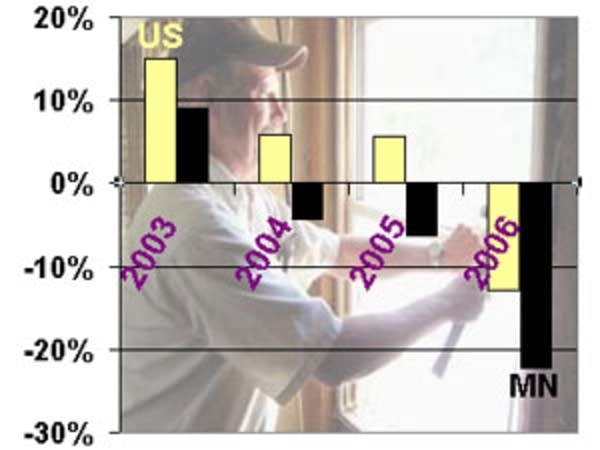Minnesota drops in some economic rankings
Go Deeper.
Create an account or log in to save stories.
Like this?
Thanks for liking this story! We have added it to a list of your favorite stories.

The St. Paul Area Association of Realtors says there were only about 7,900 home sales in the Twin Cities in the first three months of this year. That was the lowest first-quarter sales volume in 10 years.
The median price for the homes that sold fell slightly to $223,000. That was down 1 percent from a year ago. The realtors association said that finding eased fears of a real estate implosion.
Steve Hyland, president of of the St. Paul Association of Realtors, says the housing market continues to undergo a correction, one that he says is inevitable, and is returning to more normal rates of sales and price appreciation.
"We are still in the midst of a correction and a correction from a time period over the last six, eight , nine years which has been historical in terms of its boom time here in the metro area and across the country for that matter, according to Hyland.
Turn Up Your Support
MPR News helps you turn down the noise and build shared understanding. Turn up your support for this public resource and keep trusted journalism accessible to all.
The National Association of Realtors predicted the national median price for existing homes would drop this year. That would be the first decline since the trade group began keeping records in the late 1960s.
The home sales report follows a state economic update that says Minnesota's economy struggled last year. Minnesota's underperformed the national economy in several key industries, including transportation and construction.
State economist Tom Stinson says Northwest Airlines' big payroll cuts in recent years explain why Minnesota has lagged the nation in the transportation sector.
In the construction arena, Stinson suspects key manufacturers, such as Andersen and Marvin window and door manufacturers, have been hurt by the slowdown in new home construction.
Stinson expects most sectors of the state's economy will rebound to grow at the national average. But it appears the state will lack the economic strength to offset a disturbing drop in the state's ranking in terms of per-capita income.
In 2006, Minnesota ranked 46th among all states in per-capita personal income growth -- a key measure of economic strength.
"That's not something we're used to seeing; Minnesota doesn't usually rank 46th in anything desirable," Stinson said.
As a result, other states have passed Minnesota in per-capita income. Minnesota now ranks 12th in the nation in per-capita income, down from seventh in 2004. And Stinson says that Minnesota will have a hard time increasing its ranking, despite Minnesota's basically sound economy.
"The concern, though, is that there doesn't appear there is any significant sector outside of health care that we will grow faster than the national average," Stinson said. "It will be tough for us to move back up the ladder and get in the top 10 in personal income per capita."
Stinson says Minnesota has largely missed out on the economic kick provided by huge increases in federal spending on military equipment. Minnesota, Stinson notes, is not home to many big defense contractors.
Stinson says East and West Coast states have benefited the most from the boom in military spending.




